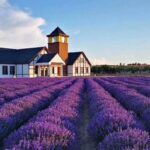Lavender farms, with their endless rows of vibrant purple flowers, have become emblematic of serenity and natural beauty. Stretching across picturesque landscapes, these farms attract visitors with their captivating aesthetics and myriad benefits. Lavender, a plant known for its aromatic and therapeutic qualities, has been cultivated for centuries. This article delves into the allure of lavender farms, their historical significance, cultivation processes, economic impact, and the environmental benefits they offer.
Historical Significance
Lavender (Lavandula) has a rich history dating back to ancient civilizations. The Egyptians used lavender in the mummification process, while the Romans utilized it for bathing, cooking, and scenting the air. The name “lavender” itself is derived from the Latin word “lavare,” meaning “to wash.” Throughout history, lavender has been prized not only for its fragrance but also for its medicinal properties. Medieval monks cultivated lavender in monastery gardens, and it was a staple in the herbal remedies of the time.
Cultivation of Lavender

Cultivating lavender requires specific climatic and soil conditions. The plant thrives in well-drained, sandy or gravelly soils with a neutral to slightly alkaline pH. Lavender prefers full sun and can tolerate drought, making it well-suited to Mediterranean climates. There are several species and varieties of lavender, each with unique characteristics and uses. Common species include Lavandula angustifolia (English lavender), Lavandula stoechas (French lavender), and Lavandula x intermedia (Lavandin).
Planting and Maintenance
Lavender is typically propagated through cuttings to ensure consistency in quality and characteristics. The planting season varies depending on the climate, but spring and early summer are generally ideal. Once planted, lavender requires minimal maintenance. Regular pruning is essential to encourage bushier growth and prevent the plant from becoming woody. Irrigation should be moderate, as overwatering can lead to root rot.
Economic Impact
Lavender farming is not only a visual delight but also a significant economic activity. The global demand for lavender and its products, such as essential oils, soaps, cosmetics, and culinary items, is ever-increasing. Lavender essential oil is one of the most popular and versatile essential oils in the market. It is used in aromatherapy for its calming effects, in cosmetics for its skin-soothing properties, and in household products for its pleasant fragrance.
Agritourism
Many lavender farms have capitalized on the rising trend of agritourism. Visitors flock to these farms to experience the beauty of the lavender fields, participate in harvest activities, and purchase lavender products. Events such as lavender festivals, yoga sessions in the fields, and lavender-infused culinary experiences draw tourists, contributing to the local economy. The picturesque nature of lavender fields also makes them popular locations for photography, weddings, and other special events.
Environmental Benefits
Lavender farming can offer several environmental benefits. Lavender plants are known for their ability to attract pollinators, such as bees and butterflies, which are crucial for the health of many ecosystems. The cultivation of lavender can contribute to biodiversity, particularly in areas where monoculture farming is prevalent. Additionally, lavender is a low-input crop, meaning it requires fewer chemical fertilizers and pesticides compared to other agricultural products, thereby reducing the environmental footprint.
Therapeutic and Medicinal Uses
Lavender has long been celebrated for its therapeutic properties. The essential oil derived from lavender flowers is widely used in aromatherapy to reduce stress, anxiety, and insomnia. Scientific studies have supported these uses, showing that lavender oil can have a calming effect on the nervous system. Topically, lavender oil is used to treat burns, insect bites, and skin irritations due to its antiseptic and anti-inflammatory properties.
Culinary Uses
Beyond its therapeutic uses, lavender is also a versatile culinary herb. Lavender buds can be used in baking, infused in beverages, and as a flavoring in savory dishes. Culinary lavender must be used sparingly due to its potent flavor, which can easily overpower other ingredients. Popular culinary uses include lavender-infused honey, lavender lemonade, and lavender-flavored baked goods.
Challenges in Lavender Farming
While lavender farming offers numerous benefits, it is not without challenges. Climate change poses a significant threat, as unpredictable weather patterns can affect lavender growth and yield. Additionally, lavender is susceptible to certain pests and diseases, such as root rot and lavender shab, which can devastate crops. Farmers must adopt sustainable practices and innovative solutions to mitigate these challenges and ensure the longevity of their lavender fields.
The Future of Lavender Farming
The future of lavender farming looks promising, driven by the continued demand for natural and sustainable products. Advances in agricultural technology, such as precision farming and organic cultivation methods, are likely to enhance productivity and sustainability. Moreover, the increasing awareness of the environmental and health benefits of lavender products is expected to drive market growth.
Innovations and Sustainability
Innovation in lavender farming is paving the way for more sustainable practices. Integrated pest management (IPM) and organic farming techniques are being adopted to reduce the reliance on chemical inputs. Additionally, research into drought-resistant lavender varieties is ongoing, aimed at ensuring that lavender farming can continue to thrive even in the face of climate change.
Conclusion
Lavender farms are more than just fields of purple flowers; they are a testament to the enduring appeal and versatility of this ancient herb. From its historical uses to its modern-day applications, lavender continues to enchant and benefit people worldwide. The cultivation and appreciation of lavender not only provide economic opportunities but also contribute to environmental sustainability and personal well-being. As the world increasingly values natural beauty and holistic health, lavender farms will undoubtedly remain cherished destinations and vital components of the agricultural landscape.